Tired ageing badmen: Criterion Blu-ray review
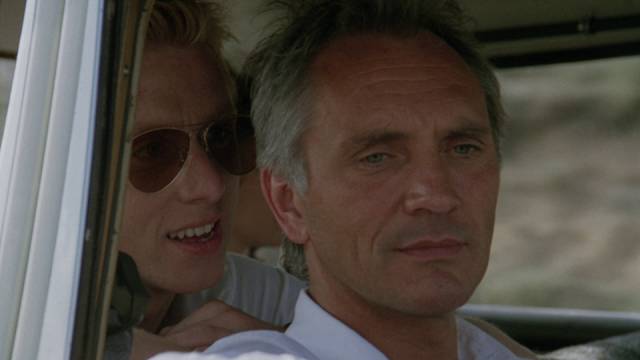
in Stephen Frears’ The Hit (1984)
We all, at times, chafe against the restrictions imposed by society on our unruly impulses. Popular culture has always found villains more interesting than heroes and upstanding citizens. Two particular strands of this tendency grew more or less side by side as cinema evolved into the 20th Century’s primary form of entertainment: The western outlaw and the urban gangster. There are obvious differences – in the western, “civilization” hadn’t yet fully taken hold in the sprawling, sparsely-populated lands stolen from indigenous peoples, and men with guns fought to impose some form of “order”; while in the gangster movie, gangs stood in opposition to an established order which they refused to acknowledge and submit themselves to. But in both cases, narratives were rooted in the conflict between supposedly self-determining individuals and the constraints imposed by social groups.
The attractive pull of these outsiders as near-mythical figures who have managed to overcome the limitations to which we ourselves have acquiesced remains strong, metastasizing into the huge popularity of vigilante superheroes on-screen and the proliferation of real-world armed fascist “militias” determined to fracture the social contract so necessary to keep large, complex societies functioning. As horrifying as this might be in the real world, the underlying narrative myth remains appealing to even the most compliant film-viewer. While such stories can be crude and reductive, at their best they explore the moral tensions inherent in the attraction to disorder; this is true in different ways in a pair of new Criterion releases, one a western from the classic age of the genre, the other a self-aware gangster movie from a later, revisionist period.
*
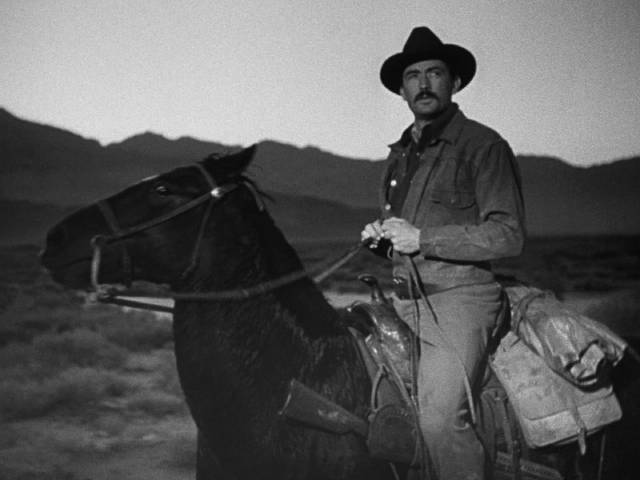
in Henry King’s The Gunfighter (1950)
The Gunfighter (Henry King, 1950)
Henry King had a long career, directing his first film in 1915 and his last in 1962. He was one of those directors whose filmography is packed with major films, prestigious productions in numerous genres, nominated for lots of awards, but who was never admitted to the pantheon of auteurs because his considerable skills were always used in the service of the material at hand rather than that material being chosen to serve his own ideas and obsessions. His defining characteristic was intelligence, an ability to dig into stories and explore their implications in ways which probably wouldn’t occur to lesser talents. In other words, he was a talented craftsman who thrived in the studio system.
The Gunfighter (1950) is a western which came at a time when the genre was undergoing a revision in the wake of World War Two and the rise of darker cultural currents most prominently represented by film noir. Like so many noir films, the movie is steeped in weariness and fatalism, the idea that – contrary to the powerful myth of the autonomous individual – no one is really in control of their own fate. The sweep of Manifest Destiny is replaced by a turning inward to individual psychology, the contradictions and flaws of personality and the fragility of a society comprised of flawed individuals.
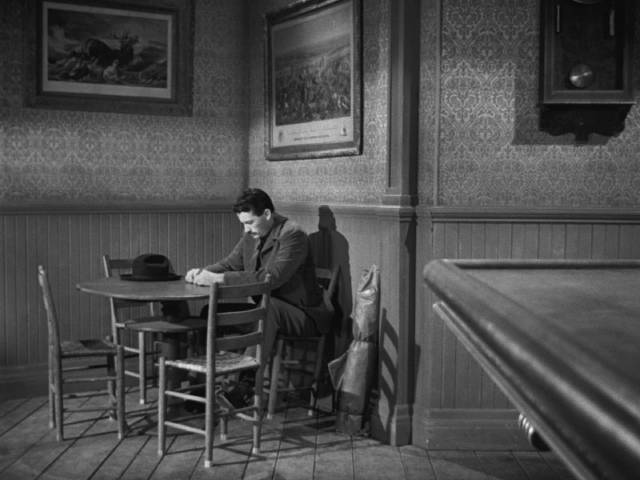
Gregory Peck is Jimmy Ringo, an outlaw grown older, and weary of a life defined by his skills with a gun. He has become trapped by his own legend and wants to disappear and live the rest of his life in peace and quiet – like many a cowboy who would follow in other revisionist westerns from Peckinpah’s Ride the High Country (1962) to Tonino Valerii’s My Name is Nobody (1973) to Don Siegel’s The Shootist (1976). At the movie’s start, Ringo rides into a small town and stops for a drink at the saloon. Immediately, King sets up the key dynamic which will shape the rest of the film. The bartender recognizes Ringo from some previous encounter and sees his presence as a draw which will bring in paying customers, while at a poker table across the room a cocky young punk (Richard Jaeckel) figures this walking legend doesn’t look so tough.
In contrast to the standard western hero, King and Peck present Ringo as a man dressed in patched together ill-fitting clothes; he makes no effort to present the image of a big man, no attempt to appear intimidating. If anything, it seems he’d rather disappear, be as anonymous as possible, though his reputation makes that all but impossible. The young punk is emboldened by this appearance of sheer ordinariness and crosses to the bar to start needling and provoking Ringo, despite everyone trying to dissuade him. It’s a familiar moment from countless other westerns, the test of nerve and skill, but King plays it almost casually – the camera cuts away from Ringo at the bar with a glass of whiskey in his right hand to the kid standing in the classic stance with hands hovering at his sides near his holsters. The kid is provoked by Ringo’s disinterest in the ritual and grabs his gun … he barely gets it out of the holster before we hear a shot and he collapses.
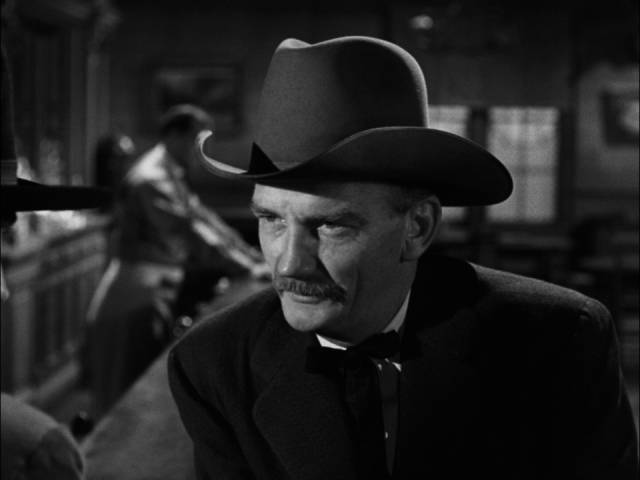
King cuts back to Ringo, now with the glass in his right hand and a smoking pistol in his left. It’s almost as if King doesn’t consider it worthwhile to display the gunfighter’s skill. Ringo looks around, demanding confirmation from everyone in the saloon that it was self-defence. Everyone agrees, but they point out that this is irrelevant because the kid has three brothers who will inevitably be looking for revenge. So Ringo can’t stop and rest; he has to keep moving, more at the mercy of his reputation than of any particular individual he encounters.
The classically structured screenplay by William Bowers and William Sellers, from a story co-written by Andre De Toth, now proceeds to build its core narrative as an elaboration of the prologue, fleshing it out with details and nuance. After an encounter in the desert with the three brothers, whom he disarms, driving away their horses and leaving them to walk, Ringo arrives in yet another town and enters yet another saloon where the bartender, Mac (Karl Malden), immediately recognizes him and sees an opportunity to profit from his presence. One of the film’s central themes comes into focus here – the strange asymmetrical relationship between a celebrity and his fans; everyone knows Ringo, but these admirers are all strangers to him. There’s a Ringo who belongs to the public who is not him, but hovers around him, obscuring who he really is.
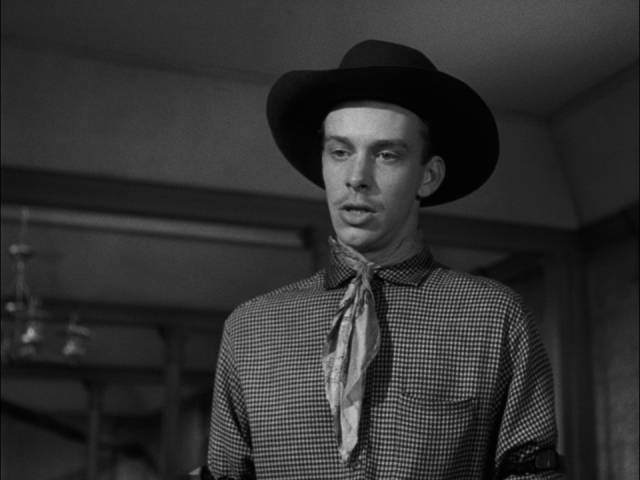
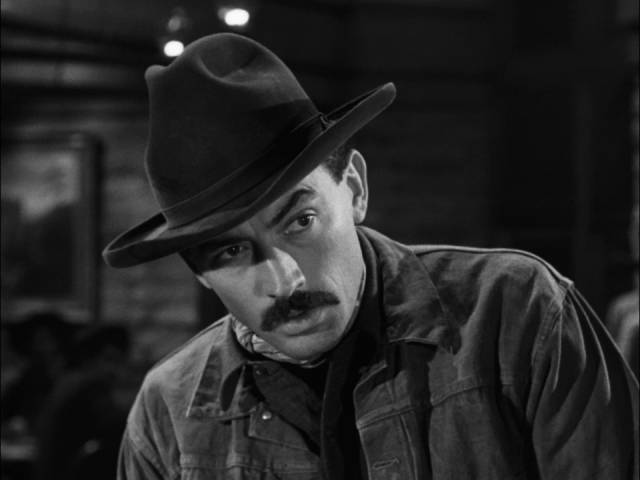
While Ringo cleans up, Mac sends for the marshal because as valuable as Ringo might be, his presence nonetheless represents a potential danger. Marshal Mark Strett (Millard Mitchell) is waiting in the saloon with his deputies when Ringo comes back in; the tension breaks when he recognizes Mark as an old acquaintance, in fact a former member of the same gang. Mark relaxes when he’s assured that Ringo intends no trouble, but he does tell his old buddy that he can’t remain in the town.
Although we’ve already seen one gunfight and the tense encounter between Ringo and the three brothers, with the meeting between Ringo and Mark in the saloon, the film settles into a rhythm which is antithetical to action. It’s about the past and the way it hangs over the present, about guilt and regret and a desire to change. Mark explains how he ended up as marshal, having hit bottom as an outlaw during a raid which turned bad – his memory of a young girl caught in crossfire could serve as the seed for the horrific slaughter at the beginning of The Wild Bunch (1969) – and his flight into a new identity which by its very nature goes counter to what he and Ringo once were. He ruefully points out that he was lucky because he was not a celebrity like Ringo; it was still possible for him to disappear and remake himself.
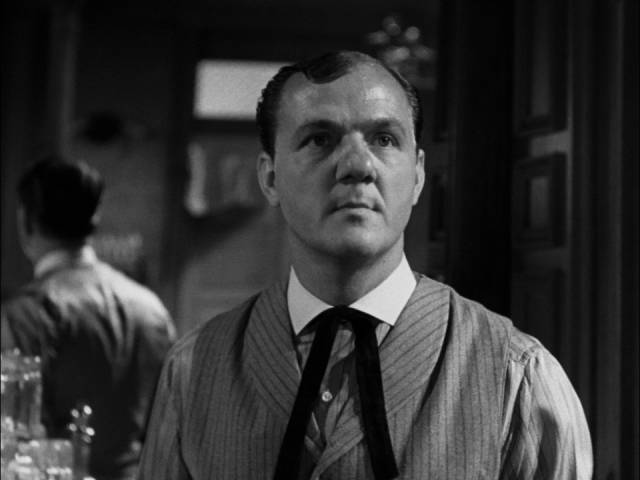
We also learn the real reason Ringo has come to this town: he’s looking for the wife and child he abandoned eight years earlier. Mark admits he knows where she is and the name she now goes by, but he’s unwilling to tell Ringo. He does finally agree to let her know Ringo is here and leave the final choice up to her. With much of the action (or inaction) confined to the saloon, The Gunfighter becomes a ticking-clock drama with multiple threads gradually weaving together into a fateful web from which Ringo has no way to escape.
The entire town gathers in the street outside the saloon, drawn by the celebrity gunfighter and a wish to see some dramatic violence; the upright ladies of the town want to see the murderer punished; the boys enact their own fantasy showdowns. The three brothers make their way towards town, first on foot, then on horses borrowed from a rancher. And there’s the inevitable young punk who wants to prove himself against the legend. Hunt Bromley (Skip Homeier), like the kid at the beginning, doesn’t think the aging Ringo looks so tough – he also, coincidentally, has been rejected by Ringo’s wife, now local schoolteacher Peggy Walsh (Helen Westcott). When Ringo humiliates him, he becomes more determined to make a name for himself.
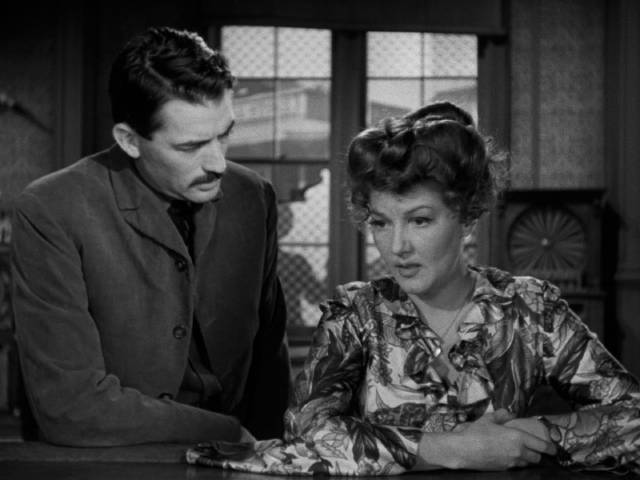
The threads draw together as time runs out – Ringo gets to see Peggy and his son (B.G. Norman), hoping to convince them to go away with him, to find somewhere further west where he’s unknown and start a new life together. Peggy is unwilling to disrupt her son’s life, but goes as far as saying that if Ringo can establish himself they could join him in a year. This last bit of hope is obviously a transient fantasy and Ringo meets his inevitable end, but again King avoids the obvious, undercutting what would have been the usual big showdown with a messy, grubby, underhanded act that belies the myth of heroic men bravely asserting themselves through noble violence. The climax is bleak and depressing in the way so many noirs end with their flawed heroes meeting an ignominious fate which there was never really any chance of them avoiding.
Gregory Peck had undeniable screen presence, but he was also undeniably rather stiff. This could serve him well as an unwaveringly decent Atticus Finch, but worked against the obsessive madness of a Captain Ahab. In The Gunfighter, King and the writers found a perfect vehicle for the actor’s distinctive persona. Ringo is constantly holding himself in, attempting to sink into the background and remain unnoticed, but his physical presence makes this impossible. Even as a point of utter stillness he draws the eye, a charismatic magnet for both potential friends and determined enemies. It’s one of the film’s chief distinctions that it makes such stillness as dramatically intense as the most elaborate action, catching the slightest change of expression as yet another revelation.
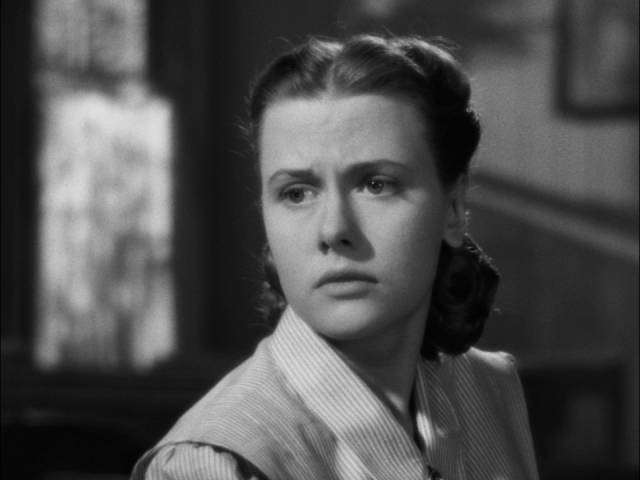
Peck is ably supported by an excellent cast in Karl Malden, Helen Westcott, Jean Parker as saloon singer Molly, Skip Homeier as the cocky engine of fate, Ellen Corby and Verna Felton as the upright ladies of the community. Most important of all is Millard Mitchell as Mark Strett, a man who managed to escape the violence and horror of outlaw life and remake himself as something decent, contributing to the community he has become a part of (it’s noted, but not made a big deal of, that he maintains order without the use of a gun).
King’s style is spare yet evocative – the sparsely-furnished and underpopulated saloon (the majority of the townspeople remain gathered in the street outside), with its low ceiling, has the air of a stage awaiting the unfolding of a tragedy and visually prefigures the waystation in Quentin Tarantino’s The Hateful Eight (2015). The cinematography of the great Arthur Miller, making his penultimate movie, is as unfussy as King’s direction, yet full of almost subliminally subtle lighting effects and movements which draw out psychological and emotional details.
Although King lacks the auteurist reputation of an Anthony Mann or an Andre De Toth, The Gunfighter is the equal of their more celebrated psychological westerns and an early example of the revisionism which would gradually overtake the genre through the 1950s and into the ’60s.
*
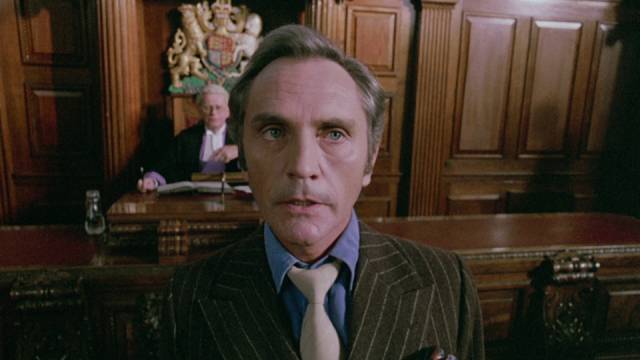
The Hit (Stephen Frears, 1984)
Stephen Frears’ The Hit (1984) isn’t so much a revisionist gangster film, although it follows from the groundbreaking example set by movies like Mike Hodges’ Get Carter (1971) and John Mackenzie’s The Long Good Friday (1980) which deromanticized the modern outlaw by situating him in a realistically delineated social and political context. Frears’ film, if anything, looks backwards, disconnecting the characters and narrative from that larger context by drawing on the almost hermetically sealed nihilism of classic noir. Here the focus is on four people and the effect they have on one another, an effect shaped by a past which now seems barely relevant to these characters.
Ten years ago, Willie Parker (Terence Stamp), a small-time Cockney gangster, ratted out his boss and gang because he couldn’t face going back to prison. His reward was a new life in a remote part of Spain. Now his boss Mr. Corrigan (Lennie Peters) is out and he wants retribution. Willie isn’t surprised when a group of men invade his villa and kidnap him, killing the Spanish policeman who has been assigned to watch over him. Somewhere out in the barren landscape, Willie is transferred to another car occupied by two Englishmen. The briefcase supposedly containing payment for the kidnappers actually contains a bomb, blowing up their car, but leaving one of them alive. Right from the start what should have been a straightforward mission – to get Willie to Paris where Mr. Corrigan is waiting for him – has become messy, drawing the attention of the Spanish police who are soon just one close step behind.
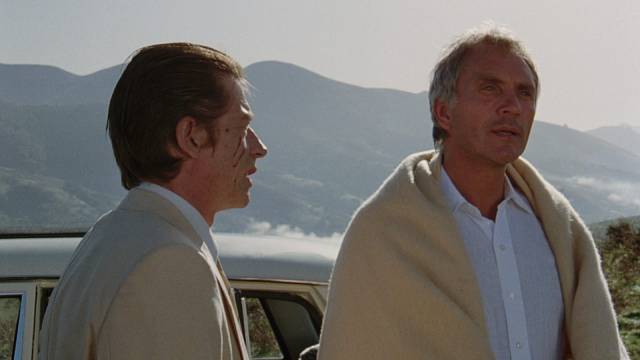
The two men tasked with retrieving Willie are an experienced killer named Braddock (John Hurt) and his annoying protege Myron (Tim Roth), on his first job. The taciturn Braddock and endlessly chatty Myron could have been a model for the pair of kidnapper-killers in the Coen Brothers’ Fargo (1996). For these two, this ought to be a simple job, but they find themselves quickly disconcerted by Willie’s beatific calmness; rather than resisting or trying to run, he seems to view his situation with amusement, taking pleasure in unsettling the two killers.
When questioned, he quietly explains that what is happening was inevitable and he has been preparing himself for years. Myron doesn’t buy it and his belief that Willie has some kind of plan prepared gnaws at him. Between Myron’s unceasing chatter and Willie’s fatalistic resignation, Braddock gradually loses the sense of certainty which has made his lethal career possible. His judgment seems to become shaky, he begins to make mistakes, the biggest of which is taking a young Spanish woman hostage.
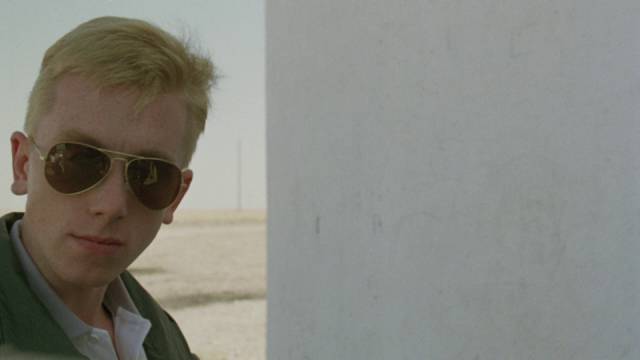
When it becomes clear that the police are on their trail, Braddock decides to make a diversion to Madrid to gain some breathing space, only to discover an Australian criminal squatting in the apartment they want to take shelter in. Harry (Bill Hunter) is understandably nervous, trying to convince Braddock that they’ve met somewhere in the past. When Harry’s girlfriend Maggie (Laura del Sol) walks in, the situation gets more complicated. Braddock decides to take her hostage to keep Harry quiet, but just as they’re about to leave in the apartment owner’s Mercedes, he decides it’s better not to leave a witness – creating yet one more bloody marker on their trail.
However, Maggie is now a new and seemingly unnecessary problem. But Myron doesn’t like the idea of killing a woman, and Braddock is no longer certain of the best course of action. With the four of them heading for the French border, Willie calmly and patiently works to amplify the growing distrust between Braddock and Myron. What began as a simple mission, to bring the grass back to the boss he betrayed for punishment, now has no sense of direction; Braddock, the cool professional, is reduced to responding moment by moment to circumstances, while Myron, who had seen becoming a mob hitman as a career choice, is discovering that the job may not suit him after all. Somehow, if only Willie had behaved as expected, fearful, pleading for his life, trying to escape, it might all have been easier. It’s his calmness, his equanimity, his amused contemplation of fate, that has disrupted Braddock’s long-held certainties. It’s a violation of the rules the underworld lives by.
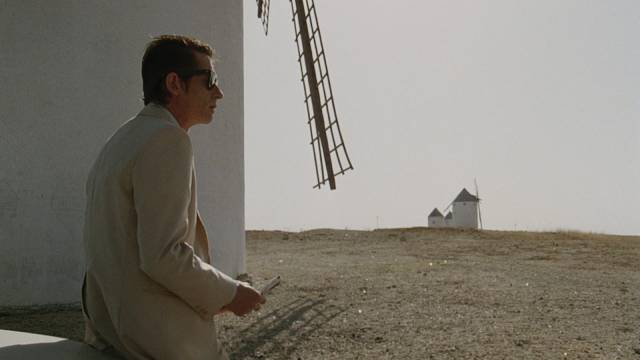
Nearing the border, everything finally falls apart in a burst of chaotic violence, with Braddock trying to dispose of all the complications although it violates his contract to bring Willie back to Mr. Corrigan. His irritating partner, the young woman determined to fight for survival, and the infuriatingly calm Willie have driven him to forget his own role as a cog in the criminal machine … something for which he himself will pay dearly in the end. Although it initially appears that Willie is the film’s protagonist, it gradually becomes apparent that the real focus is Braddock’s growing uncertainty about his own purpose and the meaning of the life he’s chosen.
Although The Hit is a contemporary gangster movie, with its parched Spanish landscapes and its few archetypal characters, it could just as well have been a spaghetti western. It strips away the superstructure of society – interestingly, while we see the police following the trail of dead bodies, it’s always from a distance which prevents us hearing what they are saying, almost as if they belong to an entirely separate dimension until the final moments when Braddock, in disguise, walks back into the real world from another, almost mythic place. A weary fatalism overwhelms everyone in this alternate reality, which like the dominant surrounding society depends on a shared adherence to agreed-upon rules to function smoothly.
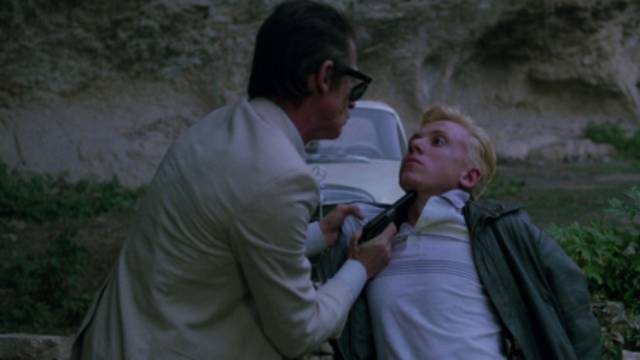
Although Stephen Frears had previously made one feature, Gumshoe (1971), he had been working prolifically on television for sixteen years before The Hit launched a successful theatrical career. Like Gumshoe, it plays with genre tropes and expectations while simultaneously undermining them, using the pre-existing forms to explore characters whose lives are to some degree shaped by familiar pop culture ideas. To a degree, this works more effectively in The Hit than it did in the more overtly self-conscious Gumshoe, and this in turn is due in part to the low-key, naturalistic performances, with Stamp and Hurt at their best and a young Tim Roth and Laura del Sol more than holding their own against those pros.
Paradoxically, the noirish bleakness is both offset and amplified by Mike Molloy’s luminous photography which sets the action in a languid, sun-drenched landscape which adds a note of absurdity to the ultimately pointless actions of these characters who are trapped by rules which have lost whatever meaning they might once have had.
*
The disks
Both films look excellent on Criterion’s Blu-rays, with the 4K restoration of The Gunfighter from a duplicate negative providing rich blacks and expressive contrast. The 2K transfer from an interpositive gives The Hit a textured, film-like look.
The supplements
On The Gunfighter, an interview with writer and archivist Gina Telaroli (22:53) provides an interesting overview of the personality and career of director Henry King, while a visual essay by film historian J.E. Smyth (22:45) focuses on the career of editor Barbara McLean and her collaborations with King, highlighting her contributions to what makes his style distinctive. It’s interesting that this disk devotes a fair amount of attention to the editor, including in addition to Smyth’s essay an audio recording of McLean from 1970 (33:11) with an emphasis on her work with King. There’s also an audio interview with King himself from 1971 (35:49), focusing on his relationship with Fox producer Darryl F. Zanuck, the importance of location shooting, and the making of The Gunfighter.
The booklet essay is by critic K. Austin Collins.
For The Hit, Criterion includes the extras from their 2009 DVD edition (which I somehow missed). There’s a group commentary with Frears, writer Peter Prince, editor Mick Audsley, and actors John Hurt and Tim Roth. There’s also an episode of Michael Parkinson’s talk show from 1988 (37:01) with Terence Stamp displaying his easygoing charm as he discusses his offbeat career.
The booklet essay is by critic Graham Fuller.
Comments
I really enjoyed The Gunfighter. I saw it in January 2018. It was packed with two other Westerns from Fox, Rawhide and Garden Of Evil, each film has it’s own disc but there weren’t many extras. The other two films were also entertaining. At the time all three were on YouTube but now only The Gunfighter is still up.
I recently watched Rich Hall’s How The West Was Lost on YouTube. Fun look at the history of the Western for the BBC. He did another special on road movies. I didn’t always agree with him but he’s entertaining.
Yeah, I have that Fox set and according to my notes I liked them all, though I honestly barely remember the other two.